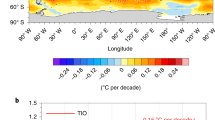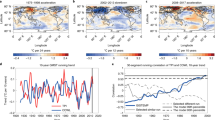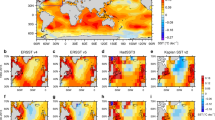Abstract
Understanding the tropical Pacific response to global warming remains challenging. Here we use a range of Coupled Model Intercomparison Project Phase 6 greenhouse warming experiments to assess the recent and future evolution of the equatorial Pacific east–west temperature gradient and corresponding Walker circulation. In abrupt CO2-increase scenarios, many models generate an initial strengthening of this gradient resembling an ocean thermostat, followed by a small weakening; other models generate an immediate weakening that becomes progressively stronger, establishing a pronounced eastern equatorial Pacific warming pattern. The initial response in these experiments is a strong predictor for the intensity of this pattern simulated in both abrupt and realistic warming scenarios, but not in historical simulations showing no multi-model-mean warming trend in this region. The likely explanation is that the recent CO2-driven changes in the tropical Pacific are masked by aerosol effects and a potential ocean-thermostat-related delay, while the eastern equatorial Pacific warming pattern will emerge as greenhouse gases overcome aerosol forcing.
This is a preview of subscription content, access via your institution
Access options
Access Nature and 54 other Nature Portfolio journals
Get Nature+, our best-value online-access subscription
$29.99 / 30 days
cancel any time
Subscribe to this journal
Receive 12 print issues and online access
$209.00 per year
only $17.42 per issue
Buy this article
- Purchase on Springer Link
- Instant access to full article PDF
Prices may be subject to local taxes which are calculated during checkout






Similar content being viewed by others
Data availability
CMIP6 data are available at https://esgf-node.llnl.gov/search/cmip6/. The individual datasets used in this study are available upon request in the event they are temporarily unavailable for download at the above directory. ERSST v4 is available at https://www.ncdc.noaa.gov/data-access/marineocean-data/extended-reconstructed-sea-surface-temperature-ersst-v4 and NCEP/NCAR Reanalysis is available at https://psl.noaa.gov/data/gridded/data.ncep.reanalysis.html#citations.
Code availability
All plots and analysis are carried out using Python v. 3.4 including the following packages: xarray, numpy, xesmf, pandas, os, matplotlib and cartopy. The majority of code used for analysis is publicly available via Github at https://github.com/ubbu36/CMIP6_pacific_analysis (ref. 56) (DOI: 343968992). All code files are available upon reasonable request.
References
Clement, A. & DiNezio, P. The tropical Pacific Ocean—back in the driver’s seat? Science 343, 976–978 (2014).
Fedorov, A. V., Burls, N. J., Lawrence, K. T. & Peterson, L. C. Tightly linked zonal and meridional sea surface temperature gradients over the past five million years. Nat. Geosci. 8, 975–980 (2015).
Kosaka, Y. & Xie, S.-P. The tropical Pacific as a key pacemaker of the variable rates of global warming. Nat. Geosci. 9, 669–673 (2016).
Pierrehumbert, R. T. Climate change and the tropical Pacific: the sleeping dragon wakes. Proc. Natl Acad. Sci. USA 97, 1355–1358 (2000).
Collins, M. et al. The impact of global warming on the tropical Pacific Ocean and El Niño. Nat. Geosci. 3, 391–397 (2010).
DiNezio, P. N. et al. Mean climate controls on the simulated response of ENSO to increasing greenhouse gases. J. Clim. 25, 7399–7420 (2012).
Fedorov, A. V. & Philander, S. G. Is El Niño changing? Science 288, 1997–2002 (2000).
England, M. H. et al. Recent intensification of wind-driven circulation in the Pacific and the ongoing warming hiatus. Nat. Clim. Change 4, 222–227 (2014).
Fedorov, A. V., Hu, S., Wittenberg, A. T., Levine, A. F. & Deser, C. in El Niño Southern Oscillation in a Changing Climate (McPhaden, M. J. et al.) 173–198 (American Geophysical Union, 2020).
Hu, S. & Fedorov, A. V. The extreme El Niño of 2015–2016 and the end of global warming hiatus. Geophys. Res. Lett. 44, 3816–3824 (2017).
McGregor, S. et al. Recent Walker circulation strengthening and Pacific cooling amplified by Atlantic warming. Nat. Clim. Change 4, 888–892 (2014).
Andrews, T. et al. Accounting for changing temperature patterns increases historical estimates of climate sensitivity. Geophys. Res. Lett. 45, 8490–8499 (2018).
Dong, Y. et al. Intermodel spread in the pattern effect and its contribution to climate sensitivity in CMIP5 and CMIP6 models. J. Clim. 33, 7755–7775 (2020).
Sohn, B.-J., Yeh, S.-W., Lee, A. & Lau, W. K. M. Regulation of atmospheric circulation controlling the tropical Pacific precipitation change in response to CO2 increases. Nat. Commun. 10, 1108 (2019).
Yeh, S.-W. et al. ENSO atmospheric teleconnections and their response to greenhouse gas forcing. Rev. Geophys. 56, 185–206 (2018).
Ceppi, P., Zappa, G., Shepherd, T. G. & Gregory, J. M. Fast and slow components of the extratropical atmospheric circulation response to CO2 forcing. J. Clim. 31, 1091–1105 (2018).
Kociuba, G. & Power, S. B. Inability of CMIP5 models to simulate recent strengthening of the Walker circulation: implications for projections. J. Clim. 28, 20–35 (2015).
Plesca, E., Grützun, V. & Buehler, S. A. How robust is the weakening of the Pacific Walker circulation in CMIP5 idealized transient climate simulations? J. Clim. 31, 81–97 (2018).
Dong, B. & Lu, R. Interdecadal enhancement of the Walker circulation over the tropical Pacific in the late 1990s. Adv. Atmos. Sci. 30, 247–262 (2013).
Ma, S. & Zhou, T. Robust strengthening and westward shift of the tropical Pacific Walker circulation during 1979–2012: a comparison of 7 sets of reanalysis data and 26 CMIP5 models. J. Clim. 29, 3097–3118 (2016).
Meng, Q. et al. Twentieth century Walker circulation change: data analysis and model experiments. Clim. Dyn. 38, 1757–1773 (2012).
Hu, S. & Fedorov, A. V. Indian Ocean warming can strengthen the Atlantic meridional overturning circulation. Nat. Clim. Change 9, 747–751 (2019).
Zhang, L. et al. Indian ocean warming trend reduces Pacific warming response to anthropogenic greenhouse gases: an interbasin thermostat mechanism. Geophys. Res. Lett. 46, 10882–10890 (2019).
Clement, A. C., Seager, R., Cane, M. A. & Zebiak, S. E. An ocean dynamical thermostat. J. Clim. 9, 2190–2196 (1996).
Liu, Z. The role of ocean in the response of tropical climatology to global warming: the west–east SST contrast. J. Clim. 11, 864–875 (1998).
Luo, Y., Lu, J., Liu, F. & Garuba, O. The role of ocean dynamical thermostat in delaying the El Niño–like response over the equatorial pacific to climate warming. J. Clim. 30, 2811–2827 (2017).
Heede, U. K., Fedorov, A. V. & Burls, N. J. Timescales and mechanisms for the tropical Pacific response to global warming: a tug of war between the Ocean Thermostat and weaker Walker. J. Clim. 33, 6101–6118 (2020).
Heede, U. K., Fedorov, A. V. & Burls, N. J. A stronger versus weaker Walker: understanding model differences in fast and slow tropical Pacific responses to global warming. Clim. Dyn. https://doi.org/10.1007/s00382-021-05818-5 (2021).
Fosu, B., He, J. & Liguori, G. Equatorial pacific warming attenuated by SST warming patterns in the tropical Atlantic and Indian oceans. Geophys. Res. Lett. 47, e2020GL088231 (2020).
Levine, A. F., McPhaden, M. J. & Frierson, D. M. The impact of the AMO on multidecadal ENSO variability. Geophys. Res. Lett. 44, 3877–3886 (2017).
Xie, S.-P. et al. Global warming pattern formation: sea surface temperature and rainfall. J. Clim. 23, 966–986 (2010).
Knutson, T. R. & Manabe, S. Time-mean response over the tropical Pacific to increased CO2 in a coupled ocean–atmosphere model. J. Clim. 8, 2181–2199 (1995).
Vecchi, G. A. & Soden, B. J. Global warming and the weakening of the tropical circulation. J. Clim. 20, 4316–4340 (2007).
Held, I. M. & Soden, B. J. Robust responses of the hydrological cycle to global warming. J. Clim. 19, 5686–5699 (2006).
Erfani, E. & Burls, N. J. The strength of low-cloud feedbacks and tropical climate: a CESM sensitivity study. J. Clim. 32, 2497–2516 (2019).
Stuecker, M. F. et al. Strong remote control of future equatorial warming by off-equatorial forcing. Nat. Clim. Change 10, 124–129 (2020).
Coats, S. & Karnauskas, K. B. Are simulated and observed twentieth century tropical Pacific sea surface temperature trends significant relative to internal variability? Geophys. Res. Lett. 44, 9928–9937 (2017).
Burls, N. J. & Fedorov, A. V. What controls the mean east–west sea surface temperature gradient in the equatorial Pacific: the role of cloud albedo. J. Clim. 27, 2757–2778 (2014).
Li, G., Xie, S.-P., Du, Y. & Luo, Y. Effects of excessive equatorial cold tongue bias on the projections of tropical Pacific climate change. Part I: the warming pattern in CMIP5 multi-model ensemble. Clim. Dyn. 47, 3817–3831 (2016).
Collins, M., The CMIP Modelling Groups (BMRC (Australia), C. (Canada), CCSR/NIES (Japan), CERFACS (France), CSIRO (Australia), MPI (Germany), GFDL (USA), GISS (USA), IAP (China), INM (Russia), LMD (France), MRI (Japan), NCAR (USA), NRL (USA), Hadley Centre (UK) and YNU (South Korea)). El Niño- or La Niña-like climate change? Clim. Dyn. 24, 89–104 (2005).
Kohyama, T. & Hartmann, D. L. Nonlinear ENSO warming suppression (NEWS). J. Clim. 30, 4227–4251 (2017).
Lee, S.-K. et al. Pacific origin of the abrupt increase in Indian Ocean heat content during the warming hiatus. Nat. Geosci. 8, 445 (2015).
Dong, L., Zhou, T. & Chen, X. Changes of Pacific decadal variability in the twentieth century driven by internal variability, greenhouse gases, and aerosols. Geophys. Res. Lett. 41, 8570–8577 (2014).
Takahashi, C. & Watanabe, M. Pacific trade winds accelerated by aerosol forcing over the past two decades. Nat. Clim. Change 6, 768–772 (2016).
Seager, R. et al. Strengthening tropical Pacific zonal sea surface temperature gradient consistent with rising greenhouse gases. Nat. Clim. Change 9, 517–522 (2019).
Zhao, B. & Fedorov, A. The effects of background zonal and meridional winds on ENSO in a coupled GCM. J. Clim. 33, 2075–2091 (2020).
Song, X. & Zhang, G. J. Role of climate feedback in El Niño–like SST response to global warming. J. Clim. 27, 7301–7318 (2014).
DiNezio, P. N. et al. Climate response of the equatorial Pacific to global warming. J. Clim. 22, 4873–4892 (2009).
Ying, J., Huang, P. & Huang, R. Evaluating the formation mechanisms of the equatorial Pacific SST warming pattern in CMIP5 models. Adv. Atmos. Sci. 33, 433–441 (2016).
Lund, M. T., Myhre, G. & Samset, B. H. Anthropogenic aerosol forcing under the Shared Socioeconomic Pathways. Atmos. Chem. Phys. 19, 13827–13839 (2019).
Watanabe, M., Dufresne, J.-L., Kosaka, Y., Mauritsen, T. & Tatebe, H. Enhanced warming constrained by past trends in equatorial Pacific sea surface temperature gradient. Nat. Clim. Change https://doi.org/10.1038/s41558-020-00933-3 (2020).
Hayashi, M., Jin, F.-F. & Stuecker, M. F. Dynamics for El Niño-La Niña asymmetry constrain equatorial-Pacific warming pattern. Nat. Commun. 11, 4230 (2020).
Eyring, V. et al. Overview of the coupled model intercomparison project phase 6 (CMIP6) experimental design and organization. Geosci. Model Dev. 9, 1937–1958 (2016).
Huang, B. et al. Extended Reconstructed Sea Surface Temperature version 4 (ERSST.v4). Part I: upgrades and intercomparisons. J. Clim. 28, 911–930 (2015).
NCEP/NCAR Reanalysis 1 (NOAA Physical Sciences Laboratory, accessed 2021); https://psl.noaa.gov/data/gridded/data.ncep.reanalysis.html
Heede, U. CMIP6 Pacific analysis. Github https://github.com/ubbu36/CMIP6_pacific_analysis (2021).
Acknowledgements
U.K.H. is supported by a NASA FINESST Fellowship (80NSSC20K1634). A.V.F. is supported by grants from NASA (80NSSC21K0558) and NOAA (NA20OAR4310377). Additional funding is provided by the ARCHANGE project (ANR-18-MPGA-0001, France). We also acknowledge a generous gift to Yale University from T. Sandoz. The funders had no role in study design, data collection and analysis, decision to publish or preparation of the manuscript. We greatly acknowledge the World Climate Research Programme, which, through its Working Group on Coupled Modelling, coordinated and promoted CMIP6. We thank the climate modelling groups for producing and making available their model output, the Earth System Grid Federation (ESGF) for archiving the data and providing access, and the multiple funding agencies who support CMIP6 and ESGF. We thank NOAA/OAR/ESRL, PSL and NCEP/NCAR, Boulder, Colorado, USA for access to datasets ERSST v4 and NCEP/NCAR Reanalysis 1. We also thank N. Burls for helpful discussions of the topic.
Author information
Authors and Affiliations
Contributions
U.K.H. and A.V.F. contributed equally to designing the research. U.K.H. performed the data analysis and, together with A.V.F., interpreted the results. U.K.H. wrote the manuscript and edited it together with A.V.F.
Corresponding author
Ethics declarations
Competing interests
The authors declare no competing interests.
Additional information
Peer review information Nature Climate Change thanks Malte Stuecker and the other, anonymous, reviewer(s) for their contribution to the peer review of this work.
Publisher’s note Springer Nature remains neutral with regard to jurisdictional claims in published maps and institutional affiliations.
Extended data
Extended Data Fig. 1 Long-term changes in the Pacific zonal surface temperature gradient versus the sea level pressure (SLP) gradient along the equator.
(a) the abrupt4xCO2 experiments and (b) the SSP5-8.5 experiments relative to the piControl experiment. Long-term anomalies are shown, defined as years 2080-2100 minus the pi-Control for the SSP5-8.5 scenario and years 100-150 for the abrupt 4xCO2 experiments. Each marker + color combination represents one model as described in the legend of Fig. 4. Negative values indicate the weakening of the temperature and SLP gradients. See Methods for the definitions of the two gradients. The SLP gradient indicates the strength of the Walker circulation. Changes in the zonal SST and SLP gradients are tightly coupled. The R and p values denote the correlation coefficients and statistical significance of Pearson’s correlation, respectively.
Extended Data Fig. 2 Changes in the Pacific zonal surface temperature gradient in the historical and SSP-3.70 experiments for each model.
A bar chart showing changes in the Pacific zonal surface temperature gradient for each model in the full-forcing historical and SSP3-7.0 simulations (c.f. Figure 5b). Changes in the historical and SSP scenarios are computed relative to the 1950-1970 baseline and compared to the observed trend (the red bar). Error bars (black) indicate ensemble spread (one standard deviation) for models that include at least 3 ensemble members.
Extended Data Fig. 3 Model mean state at low latitudes for the OT and EP categories.
(a,c) Mean state SST and (b,d) SLP and surface winds for the OT and EP model categories (see main text) based on at least a 150-year average of piControl. Panels (e, f) show the mean state difference between the two categories. The OT models are generally colder in the Indo-Pacific, except in the regions off the coast of South and North America, but have weaker easterly winds in the equatorial band.
Extended Data Fig. 4 Model mean state biases for the OT and EP categories.
Mean state (a,c) SST and (b,d) SLP biases for the OT and EP categories relative to the observed. The model mean state is based on at least a 150-year average of piControl. The observed mean state is based on monthly SST from ERSST v4 for years 1850-1970 and monthly mean SLP from NCEP-NCAR Reanalysis 1 for years 1950-2000. Hatching indicates areas where 80% or more of models agree on the sign of the bias. The RMS errors for the region (60 o E to 60 o W, 30 o S to 30o N, land excluded) are 0.68 K and 41 Pa for the OT category and 0.34 K and 44 Pa for the EP category.
Extended Data Fig. 5 Equatorial mean state of the OT and EP models.
Profiles of (a,c) SST and (b,d) wind stress along the equator for the OT (blue) and EP (red) categories compared to the observations (black). The model mean state is based on at least a 150-year average of piControl. The green dashed line indicates a multi-model mean for all 40 models. The observations are based on monthly SST for years 1850-1970 from ERSST v4 and monthly mean SLP and winds from NCEP-NCAR Reanalysis 1 for years 1950-2000. Grey lines indicate individual models in each category.
Extended Data Fig. 6 Anomalies in SST, sea level pressure (SLP) and surface winds in experiments with full or partial historical forcing.
As in Fig. 6 but panels on the left include hatching to indicate that 80% or more of the models agree on the sign of the trend relative to the area mean SST warming (60oE to 60 oW, 30oS to 30oN, land excluded).
Extended Data Fig. 7 Evolution of the Pacific surface temperature gradient for selected models in historical simulations.
Examples of time evolution of the Pacific zonal temperature gradient (blue) in three selected models relative to the 1950-1970 baseline, compared to the observed changes (red). The ensemble mean is plotted in blue and individual ensemble members are plotted in grey. The first row is the historical full-forcing experiments, the second row is the GHG-only historical runs, and the third row is the aerosol-only historical runs. The observed timeseries are from ERSST v4. A 15-year running mean is applied. Positive values indicate the strengthening of the zonal temperature gradient and hence the Walker circulation.
Extended Data Fig. 8 Historical surface temperature anomalies for HadGEM3-GC31-LL.
Surface temperature anomalies produced by the HadGEM31-GC31-LL model in (a) full-forcing, (b) GHG-only and (c) aerosols-only historical experiments. The anomalies are calculated as years 2000-2014 minus 1950-1970. (d) A linear superposition of the GHG-only and aerosols-only anomalies. Noticeable differences between this last panel and the historical full-forcing anomalies in panel (a) indicate nonlinear interaction between the effects of GHG and aerosol forcing.
Extended Data Fig. 9 Historical surface temperature anomalies for CNRM-CM6.
As in Extended Data Fig. 8, but for CNRM-CM6. Here, panels (a) and (d) are nearly identical, which indicates that in this model the GHG and aerosol forcings act independently with no nonlinear interaction.
Extended Data Fig. 10 Historical surface temperature anomalies for MIROC6.
As in Extended Data Fig. 8, but for MIROC6. Here, panels (a) and (d) are very similar, which indicates that in this model the GHG and aerosol forcings act independently with no nonlinear interaction.
Supplementary information
Supplementary Information
Supplementary Fig. 1 and Table 1.
Rights and permissions
About this article
Cite this article
Heede, U.K., Fedorov, A.V. Eastern equatorial Pacific warming delayed by aerosols and thermostat response to CO2 increase. Nat. Clim. Chang. 11, 696–703 (2021). https://doi.org/10.1038/s41558-021-01101-x
Received:
Accepted:
Published:
Issue Date:
DOI: https://doi.org/10.1038/s41558-021-01101-x
This article is cited by
-
Optimizing potassium polysulfides for high performance potassium-sulfur batteries
Nature Communications (2024)
-
Historical changes in wind-driven ocean circulation drive pattern of Pacific warming
Nature Communications (2024)
-
Revisiting the equatorial Pacific sea surface temperature response to global warming
Climate Dynamics (2024)
-
Satellite-observed strong subtropical ocean warming as an early signature of global warming
Communications Earth & Environment (2023)
-
A high concentration CO2 pool over the Indo-Pacific Warm Pool
Scientific Reports (2023)



